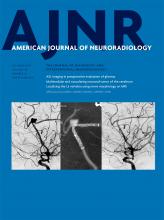Index by author
Vargas, Maria Isabel
- You have accessPerspectivesMaria Isabel VargasAmerican Journal of Neuroradiology October 2017, 38 (10) 1849; DOI: https://doi.org/10.3174/ajnr.P0042
Varghese, T.
- Adult BrainOpen AccessAssessment of Iron Deposition in the Brain in Frontotemporal Dementia and Its Correlation with Behavioral TraitsR. Sheelakumari, C. Kesavadas, T. Varghese, R.M. Sreedharan, B. Thomas, J. Verghese and P.S. MathuranathAmerican Journal of Neuroradiology October 2017, 38 (10) 1953-1958; DOI: https://doi.org/10.3174/ajnr.A5339
Verburg, N.
- Adult BrainYou have accessDiagnostic Accuracy of Neuroimaging to Delineate Diffuse Gliomas within the Brain: A Meta-AnalysisN. Verburg, F.W.A. Hoefnagels, F. Barkhof, R. Boellaard, S. Goldman, J. Guo, J.J. Heimans, O.S. Hoekstra, R. Jain, M. Kinoshita, P.J.W. Pouwels, S.J. Price, J.C. Reijneveld, A. Stadlbauer, W.P. Vandertop, P. Wesseling, A.H. Zwinderman and P.C. De Witt HamerAmerican Journal of Neuroradiology October 2017, 38 (10) 1884-1891; DOI: https://doi.org/10.3174/ajnr.A5368
Verghese, J.
- Adult BrainOpen AccessAssessment of Iron Deposition in the Brain in Frontotemporal Dementia and Its Correlation with Behavioral TraitsR. Sheelakumari, C. Kesavadas, T. Varghese, R.M. Sreedharan, B. Thomas, J. Verghese and P.S. MathuranathAmerican Journal of Neuroradiology October 2017, 38 (10) 1953-1958; DOI: https://doi.org/10.3174/ajnr.A5339
Vittorini, R.
- Pediatric NeuroimagingOpen AccessNeuroimaging Changes in Menkes Disease, Part 2R. Manara, M.C. Rocco, L. D'agata, R. Cusmai, E. Freri, L. Giordano, F. Darra, E. Procopio, I. Toldo, C. Peruzzi, R. Vittorini, A. Spalice, C. Fusco, M. Nosadini, D. Longo and S. Sartori the Menkes Working Group in the Italian Neuroimaging Network for Rare DiseasesAmerican Journal of Neuroradiology October 2017, 38 (10) 1858-1865; DOI: https://doi.org/10.3174/ajnr.A5192
Wadhwa, V.
- You have accessMaximizing the Tweet Engagement Rate in Academia: Analysis of the AJNR Twitter FeedV. Wadhwa, E. Latimer, K. Chatterjee, J. McCarty and R.T. FitzgeraldAmerican Journal of Neuroradiology October 2017, 38 (10) 1866-1868; DOI: https://doi.org/10.3174/ajnr.A5283
Walsh, J.P.
- FELLOWS' JOURNAL CLUBAdult BrainYou have accessImproved Detection of Anterior Circulation Occlusions: The “Delayed Vessel Sign” on Multiphase CT AngiographyD. Byrne, G. Sugrue, E. Stanley, J.P. Walsh, S. Murphy, E.C. Kavanagh and P.J. MacMahonAmerican Journal of Neuroradiology October 2017, 38 (10) 1911-1916; DOI: https://doi.org/10.3174/ajnr.A5317
The authors evaluated 23 distal anterior circulation occlusions during a 2-year period. Ten M1-segment occlusions and 10 cases without a vessel occlusion were also included. There was significant improvement in the sensitivity of detection of distal anterior circulation vessel occlusions, overall confidence, and time taken to interpret with multiphase CTA compared with single-phase CTA. The delayed vessel sign is a reliable indicator of anterior circulation vessel occlusion, particularly in cases involving distal branches.
Wang, Y.
- FunctionalOpen AccessAnatomic Location of Tumor Predicts the Accuracy of Motor Function Localization in Diffuse Lower-Grade Gliomas Involving the Hand Knob AreaS. Fang, J. Liang, T. Qian, Y. Wang, X. Liu, X. Fan, S. Li, Y. Wang and T. JiangAmerican Journal of Neuroradiology October 2017, 38 (10) 1990-1997; DOI: https://doi.org/10.3174/ajnr.A5342
- FunctionalOpen AccessAnatomic Location of Tumor Predicts the Accuracy of Motor Function Localization in Diffuse Lower-Grade Gliomas Involving the Hand Knob AreaS. Fang, J. Liang, T. Qian, Y. Wang, X. Liu, X. Fan, S. Li, Y. Wang and T. JiangAmerican Journal of Neuroradiology October 2017, 38 (10) 1990-1997; DOI: https://doi.org/10.3174/ajnr.A5342
Warmuth-metz, M.
- FELLOWS' JOURNAL CLUBAdult BrainYou have accessMultinodular and Vacuolating Neuronal Tumor of the Cerebrum: A New “Leave Me Alone” Lesion with a Characteristic Imaging PatternR.H. Nunes, C.C. Hsu, A.J. da Rocha, L.L.F. do Amaral, L.F.S. Godoy, T.W. Watkins, V.H. Marussi, M. Warmuth-Metz, H.C. Alves, F.G. Goncalves, B.K. Kleinschmidt-DeMasters and A.G. OsbornAmerican Journal of Neuroradiology October 2017, 38 (10) 1899-1904; DOI: https://doi.org/10.3174/ajnr.A5281
The most recent 2016 WHO classification includes MVNT as a unique cytoarchitectural pattern of gangliocytoma, though it remains unclear whether MVNT is a true neoplastic process or a dysplastic hamartomatous/malformative lesion. The authors report 33 cases of presumed multinodular and vacuolating neuronal tumor of the cerebrum that exhibit a remarkably similar pattern of imaging findings consisting of a subcortical cluster of nodular lesions. They conclude that these are benign, nonaggressive lesions that do not require biopsy in asymptomatic patients and behave more like a malformative process than a true neoplasm.
- Adult BrainYou have accessImaging Biomarkers for Adult Medulloblastomas: Genetic Entities May Be Identified by Their MR Imaging RadiophenotypeV.C. Keil, M. Warmuth-Metz, C. Reh, S.J. Enkirch, C. Reinert, D. Beier, D.T.W. Jones, T. Pietsch, H.H. Schild, E. Hattingen and P. HauAmerican Journal of Neuroradiology October 2017, 38 (10) 1892-1898; DOI: https://doi.org/10.3174/ajnr.A5313
Watkins, T.W.
- FELLOWS' JOURNAL CLUBAdult BrainYou have accessMultinodular and Vacuolating Neuronal Tumor of the Cerebrum: A New “Leave Me Alone” Lesion with a Characteristic Imaging PatternR.H. Nunes, C.C. Hsu, A.J. da Rocha, L.L.F. do Amaral, L.F.S. Godoy, T.W. Watkins, V.H. Marussi, M. Warmuth-Metz, H.C. Alves, F.G. Goncalves, B.K. Kleinschmidt-DeMasters and A.G. OsbornAmerican Journal of Neuroradiology October 2017, 38 (10) 1899-1904; DOI: https://doi.org/10.3174/ajnr.A5281
The most recent 2016 WHO classification includes MVNT as a unique cytoarchitectural pattern of gangliocytoma, though it remains unclear whether MVNT is a true neoplastic process or a dysplastic hamartomatous/malformative lesion. The authors report 33 cases of presumed multinodular and vacuolating neuronal tumor of the cerebrum that exhibit a remarkably similar pattern of imaging findings consisting of a subcortical cluster of nodular lesions. They conclude that these are benign, nonaggressive lesions that do not require biopsy in asymptomatic patients and behave more like a malformative process than a true neoplasm.








